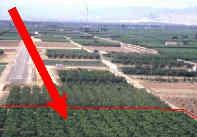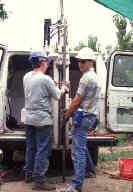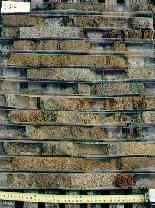Nitrate Transport
Nitrate Transport in Thick, Unsaturated, Alluvial Sediments
Principal Investigator:
Thomas Harter
Other Investigators (also at UC Davis):
Jan Hopmans, Willi Horwath, Sanjai Parikh, Kate Scow, Alex Furman (Israel), Estathis Diamantopoulos
Student Researchers and Staff:
Farag Botros, Michelle Denton, Sevim Onsoy, Tad Doane, Katrin Heeren, Jim McIntyre
Nitrate-N is the most widespread contaminant in groundwater, causing as much as ten times as many well closures in California as all other industrial contamination combined. While a large amount of research has focused on nitrogen cycling in the root zone of California tree fruit orchards (0-6 ft depth), little is known about the fate of nitrogen between the root zone and the groundwater table. Unlike other agricultural regions of the United States, groundwater levels in many areas of Central and Southern California are from 30 ft to over 100 ft deep. Therefore, the deep vadose zone is a critical link between agricultural sources and groundwater. Few studies have surveyed nitrogen levels or denitrification rates at such depths or monitored leaching of nitrogen to a deep water table. Field-scale spatial variability of nitrate levels due to natural variability of soils and vadose zone sediments also remains unaccounted for in most work on groundwater quality impacts of agricultural nitrogen management. The objectives of the proposed research are:
- Investigate the fate of nitrogen throughout the entire deep vadose zone at a well-controlled, long-term research orchard with a stratigraphy typical of many areas on the east side of the San Joaquin Valley and Southern California, and with management practices representative of orchards and vineyards
- Develop and validate appropriate modeling tools to assess the fate of nitrogen in deep, heterogeneous vadose zones



|
In the initial phase of the project, we drilled and characterized approximately 3000-ft of geologic material from 60 cores drilled to groundwater at a 52-ft depth. Eighteen cores were sampled at each of three subplots in the orchard, The subplots had been subject to a twelve-year fertilization trial with different rates of fertilization: The annual fertilization rates had been less than 5 lb/ac in the first subplot (0 lbs/ac treatment), 100 lbs/ac in the second subplot, and 325 lbs/ac in the third subplot. Drilling and field analysis during the initial months of the project provided a detailed characterization of the geologic architecture that makes up the vadose zone underneath the orchard. We were able to map several ancient soil horizons throughout the orchard. These ancient soil horizons are typically much less permeable than the remaining sediments and impede downward movement of percolating water. Our hypothesis that these so-called paleo-soils may potentially be conducive to denitrification of nitrate-N were not confirmed by isotope analyses (Harter et al., 2005). We also mapped out former river channels of the Kings River that meandered through the orchard during, or prior to, the last ice age. These channels are composed primarily of clean sands that readily percolate soil water and any nitrate dissolved in the water. We implemented laboratory and computer analysis to determine the distribution of nitrate and other chemical parameters in the vadose zone and to determine the hydraulic properties of the various geologic units we encountered underneath the orchard (Onsoy et al., 2005; Botros et al., 2009). We have also implemented various modeling approaches that account for the spatial variability of the vadose zone to investigate the role of heterogeneity on groundwater recharge and nitrate transport through the deep vadose zone (Vereecken et al., 2007, 2008; Botros et al., 2012). The project provides a comprehensive analysis of the geologic framework, the hydraulic framework associated with the geologic framework, and the geochemical process framework of groundwater recharge and nitrate transport in a deep alluvial vadose zone.
Software Tools:
Neuro Multistep - A simple computer program to estimate hydraulic functions from basic soil texture data.
Publications:
Baram, S., V. Couvreur, T. Harter, M. Read, P.H. Brown, M. Kandelous, D.R. Smart, and J.W. Hopmans, 2016. Estimating Nitrate Leaching to Groundwater from Orchards: Comparing Crop Nitrogen Excess, Deep Vadose Zone Data-Driven Estimates, and HYDRUS Modeling. Vadose Zone J. 15. doi:10.2136/vzj2016.07.0061 (open access).
Ransom, K. M., M. N. Grote, A. Deinhart, G. Eppich, C. Kendall, M. E. Sanborn, A. K. Souders, J. Wimpenny, Q.-Z. Yin, M. Young, and T. Harter, 2016. Bayesian nitrate source apportionment to individual groundwater wells in the Central Valley by use of elemental and isotopic tracers, Water Resour. Res., 52, 5577–5597, doi:10.1002/2015WR018523 (open access).
Baram S., V. Couvreur, T. Harter, M. Read, P.H. Brown, J.W. Hopmans, D.R. Smart, 2016. Assessment of orchard N losses to groundwater with a vadose zone monitoring network. Agricultural Water Management 172:83-95. doi:10.1016/j.agwat.2016.04.012
O'Geen, T., M.B.B. Saal, H.E. Dahlke, D.A. Doll, R.B. Elkins, A. Fulton, G.E. Fogg, T. Harter, J.W. Hopmans, C. Ingels, F.J. Niederholzer, S. Sandoval-Solis, P.S. Verdegaal, M. Walkinshaw, 2015. Soil suitability index identifies potential areas for groundwater banking on agricultural lands. California Agriculture 69(2):75-84, doi: 10.3733/ca.v069n02p75 (open access).
Dzurella, K.N., G. S. Pettygrove, A. Fryjoff-Hung, A. Hollander, and T. Harter, 2015. Potential to assess nitrate leaching vulnerability of irrigated cropland. J. Soil and Water Conservation 70(1):63-72, doi: 10.2489/jswc.70.1.63 (open access).
Rosenstock, T. S., D. Liptzin, K. Dzurella, A. Fryjoff-Hung, A. Hollander, V. Jensen, A. King, G. Kourakos, A. McNally, G. S. Pettygrove, J. Quinn, J. H. Viers, T. P. Tomich, and T. Harter, 2014. Agriculture's contribution to nitrate contamination of Californian groundwater (1945-2005), J. Env. Qual. 43(3):895-907, doi:10.2134/jeq2013.10.0411 (open access).
Liang, X. Q., T. Harter, L. Porta, C. van Kessel, and B. A. Linquist, 2014. Nitrate leaching in Californian rice fields: A field- and regional-scale assessment, J. Env. Qual. 43(3):881-894, doi:10.2134/jeq2013.10.0402.
Viers, J.H., Liptzin, D., Rosenstock, T.S., Jensen, V.B., Hollander, A.D., McNally, A., King, A.M., Kourakos, G., Lopez, E.M., De La Mora, N., Fryjoff-Hung, A., Dzurella, K.N., Canada, H.E., Laybourne, S., McKenney, C., Darby, J., Quinn, J.F. & Harter, T., 2012. Nitrogen Sources and Loading to Groundwater. Technical Report 2, 323p., in: Addressing Nitrate in California’s Drinking Water with a Focus on Tulare Lake Basin and Salinas Valley Groundwater. Report for the State Water Resources Control Board Report to the Legislature. Center for Watershed Sciences, University of California, Davis. (free public access).
Boyle, D., King, A., Kourakos, G., Lockhart, K., Mayzelle, M., Fogg, G.E. & Harter, T., 2012. Groundwater Nitrate Occurrence. Technical Report 4, 277p., in: Addressing Nitrate in California’s Drinking Water with a Focus on Tulare Lake
Basin and Salinas Valley Groundwater. Report for the State Water Resources Control Board Report to the Legislature. Center for Watershed Sciences, University of California, Davis (free public access).
Furman, A., T. Harter N. Weisbrod, S. Parikh, A. Shaviv, F. Mukome, R. Schmidt, H. Ouaknin, and M. Shachar, 2014. Role of Microbiological and Geochemical Heterogeneity in the Fate and Transport of Nitrogen through the Vadose Zone. BARD (Binational Agricultural Research and Development Fund (BARD). Final Report Project IS-4356-10, 32 p.
Botros, F.E., Y.S. Onsoy, T.R. Ginn, and T. Harter, 2012. Richards equation-based modeling to estimate flow and nitrate transport in a deep alluvial vadose zone, Vadose Zone Journal Vol. 11(4), doi:10.2136/vzj2011.014 (free public access).
Botros, F. E., T. Harter, Y. S. Onsoy, A. Tuli, J. W. Hopmans, 2009. Spatial variability of hydraulic properties and sediment characteristics in a deep alluvial unsaturated zone. Vadose Zone Journal 8:276–289 doi:10.2136/vzj2008.0087 (free public access)
Vereecken, H., T. Kamai, T. Harter, R. Kasteel, J. W. Hopmans, J. A. Huisman, and J. Vanderborght, 2008. Comment on "Field observations of soil moisture variability across scales" by James S. Famiglietti et al., Water Resour. Res., 44, W12601, doi:10.1029/2008WR006911. (pdf file for personal use only)
Vereecken, H., T. Kamai, T. Harter, R. Kasteel, J. Hopmans, and J. Vanderborght, 2007. Explaining soil moisture variability as a function of mean soil moisture: A stochastic unsaturated flow perspective, Geophys. Res. Lett., 34, L22402, doi:10.1029/2007GL031813.
Harter, T., Y. S. Onsoy, K. Heeren, M. Denton, G. Weissmann, J. W. Hopmans, W. R. Horwath, 2005. Deep vadose zone hydrology demonstrates fate of nitrate in eastern San Joaquin Valley, California Agriculture 59(2):124-132. (click here for pdf file, personal use only)
Onsoy, Y. S., T. Harter, T. R. Ginn, W. R. Horwath, 2005. Spatial variability and transport of nitrate in a deep alluvial vadose zone. Vadose Zone J. 4:41-55. (pdf file for personal use only)
Nakamura, K., T. Harter, Y. Hirono, H. Horino, and T. Mitsuno, 2004. Assessment of root zone nitrogen leaching as affected by irrigation and nutrient management practices. Vadose Zone J. 3:1353–1366. (pdf file for personal use only)
Denton, M., Y. S. Onsoy, T. Harter, J. W. Hopmans, W. R. Horwath, 2004. Long-term nitrate leaching below the root zone in California tree-fruit orchards, Technical Completion Report, Univ. of California Water Resources Center, 128p. (pdf file for personal use only)
Minasny, B., J. W. Hopmans, T. Harter, S. O. Eching, A. Tuli, M. A. Denton, 2004. Neural networks prediction of soil hydraulic functions for alluvial soils using multistep outflow data, Soil Science Soc. Of Am. Journal 68:417-429.
Wang, Zhi; Wu, Laosheng; Harter, Thomas; Lu, Jianhang; Jury, William A., 2003. A field study of unstable preferential flow during soil water redistribution, Water Resour. Res. Vol. 39 No. 4, 10.1029/2001WR000903, 01 April 2003.
Harter, T., K. Heeren, and W. R. Horwath. 2002. Nitrate distribution in a deep, alluvial unsaturated zone: Geologic control vs. fertilizer management. Proceedings, 2002 California Plant and Soil Conference, February 5-6, 2002, Fresno, CA, pp. 73-83 (pdf file for personal use only)
Wang, Zhi, Jianhang Lu, Laosheng Wu, Thomas Harter, William A. Jury, 2002. Visualizing preferential flow path using ammonium carbonate and a pH indicator. Soil Science Soc. Am. J. 66:347-351.
Tuli, A., M.A. Denton, J.W. Hopmans, T. Harter, and J.L. Mac Intyre. 2001. Multi-step outflow experiment: From soil preparation to parameter estimation . Hydrology program, Dept of Land, Air, and Water Resources, University of California, Davis, CA, Paper number 100037. (pdf file for personal use only) !(File Missing)!
